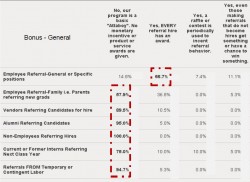 Employee referral programs may produce more hires — perhaps many more — than surveys would suggest.
Employee referral programs may produce more hires — perhaps many more — than surveys would suggest.
Over the years it has come to be accepted that the average number of new hires coming from employee referral programs is somewhere between SHRM’s 24 percent (for non-exempt positions) to about a third. Some programs do much better.
From CareerXroads now comes evidence that the hires from employee referrals are undercounted.
“Referrals permeate the recruiting process more than we think,” says recruiting consultant Gerry Crispin, a CareerXroads principal.
H![]() e and his partner, Mark Mehler, surveyed their clients and others about employee referral programs and found that most of the 50 respondents have a referral program, most pay a bonus of some kind, and on average 28 percent of their external hires are referrals.
e and his partner, Mark Mehler, surveyed their clients and others about employee referral programs and found that most of the 50 respondents have a referral program, most pay a bonus of some kind, and on average 28 percent of their external hires are referrals.
Most of the results, says Crispin, were expected. However, in comparing data from that admittedly limited, and unscientific survey with the early results of the consultancy’s annual Source of Hire study, “we’re finding referrals are a part of every source or almost every.”
For instance, rehires, a small, but steady source of hires, include a sizable percentage of individuals referred by employees. The rehires may first come to the attention of recruiters through a referral, but when they’re onboarded, the source of hire tends to get reported as a rehire.
It’s a “classification issue,” explains Crispin. A similar situation occurs with sourcers. They will be reported as the source of a hire even when they identified a candidate as a result of a referral from an employee.
Crispin and Mehler included an early indication of the pervasiveness of employee referrals in their survey results, posted online here at SlideShare. The numbers are still being crunched for the forthcoming source of hire survey (tentatively to be titled “Channels of Influence”), so there’s no data cited for the contribution referrals make to these other sources.
However, the share of the pie that referrals make to the total hires attributed to these other sources is labeled. As Crispin observed, “With just what we can count, referral programs make a big contribution.”
Much of the other data in the survey report will be useful to recruiters for comparing their own results. The surveyed companies, the report preface notes, are “large, highly-competitive firms.” Some make upwards of 10,000 hires a year. More, though, make 1,000 or less.
Big or small, two-thirds of the respondents offer a bonus for every referral hire. Most common (44 percent) is $500 for a non-exempt hire. One-in-five will pay $1,000 and a few more (28 percent) will pay that for difficult to fill non-exempt positions.
It takes about 10.4 referrals on average to make a hire. Some companies are either so picky or get so many referrals that only one referral in 25 or more results in a hire.

One other significant stat coming out of the survey is that the majority of employers don’t give the referred candidate any special treatment. Of the 39 percent that do, the comments cited in the results suggest that many don’t do much more than review the resume or application.
On the other hand, 85 percent of the employees who made a referral will get a thank you whether or not a hire is made.
One of the survey’s only surprises, Crispin said, it that employers that don’t dedicate staff to managing and promoting the referral program actually do better than those with staff assigned.
The 53.6 percent of companies that divvy up the work among the recruiting staff average about 33 percent of hires from referrals. Those with some dedicated support average about 24 percent.
“It’s counterintuitive,” Crispin agreed. The result could be just an aberration. Or, he speculated, it could be spreading the work means there’s more overall time invested in the program. Or, it could be the “silo effect” effect, that is when one person is tasked with a job, everyone else leaves things up to them.
“Now that I’ve seen that,” Crispin notes, “I’d be curious to see if someone could replicate it … for now, it’s just an artifact.”